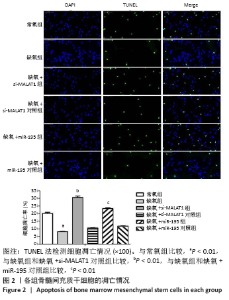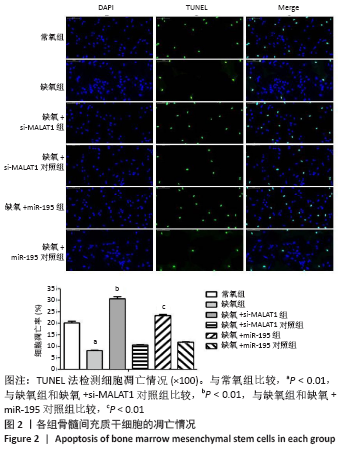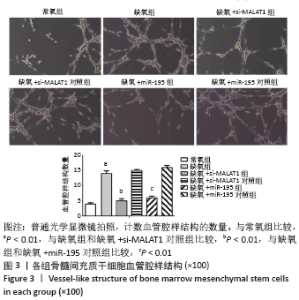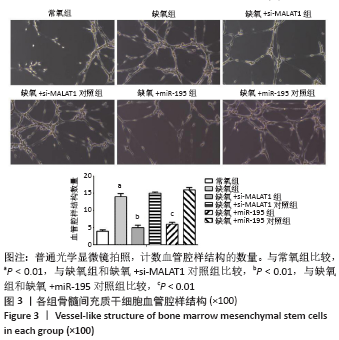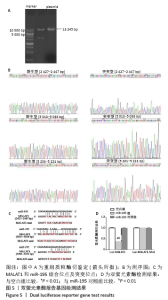Chinese Journal of Tissue Engineering Research ›› 2022, Vol. 26 ›› Issue (7): 1005-1011.doi: 10.12307/2022.136
Previous Articles Next Articles
Hypoxia preconditioning targets and downregulates miR-195 and promotes bone marrow mesenchymal stem cell survival and pro-angiogenic potential by activating MALAT1
Hou Jingying, Guo Tianzhu, Yu Menglei, Long Huibao, Wu Hao
- Emergency Department, Sun Yat-sen Memorial Hospital, Sun Yat-sen University, Guangzhou 510120, Guangdong Province, China
-
Received:2020-06-05Revised:2020-06-06Accepted:2020-06-20Online:2022-03-08Published:2021-10-29 -
Contact:Hou Jingying, MD, Associate chief physician, Emergency Department, Sun Yat-sen Memorial Hospital, Sun Yat-sen University, Guangzhou 510120, Guangdong Province, China -
About author:Hou Jingying, MD, Associate chief physician, Emergency Department, Sun Yat-sen Memorial Hospital, Sun Yat-sen University, Guangzhou 510120, Guangdong Province, China -
Supported by:the National Natural Science Foundation of China, No. 81700242 (to HJY); the Science and Technology Project of Guangdong Province, No. 2017A020215176 (to HJY); the Guangdong Medical Research Fund, No. A2017001 (to HJY); the Guangzhou Science and Technology Project, No. 202102080386, No. 202002020004 (to HJY)
CLC Number:
Cite this article
Hou Jingying, Guo Tianzhu, Yu Menglei, Long Huibao, Wu Hao. Hypoxia preconditioning targets and downregulates miR-195 and promotes bone marrow mesenchymal stem cell survival and pro-angiogenic potential by activating MALAT1 [J]. Chinese Journal of Tissue Engineering Research, 2022, 26(7): 1005-1011.
share this article
Add to citation manager EndNote|Reference Manager|ProCite|BibTeX|RefWorks
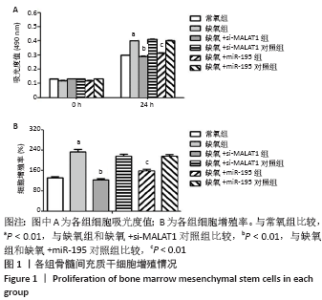
2.1 骨髓间充质干细胞增殖情况 各组0 h的吸光度值差异无显著性意义(P > 0.05),而缺氧组24 h的吸光度值明显高于常氧组(0.400±0.002 vs. 0.300±0.000,P < 0.01),缺氧+ si-MALAT1组的吸光度值明显低于缺氧组和缺氧+si-MALAT1对照组(P < 0.01),3组分别为0.290±0.004,0.400±0.002和0.410±0.004;缺氧+miR-195组的吸光度值明显低于缺氧组和缺氧+miR-195对照组(P < 0.01),3组分别为0.310±0.006,0.400±0.002和0.410±0.004,见图1A。细胞增殖率比较结果显示:缺氧组细胞增殖率也较常氧组显著升高,两者分别为(233.33±8.70)%和(130.80±5.20)% (P < 0.01);缺氧+si-MALAT1组的增殖率明显低于缺氧组和缺氧组+si-MALAT1对照组,3组分别为(123.08±4.50)%,(233.33±8.70)%和(215.38±7.40)% (P < 0.01),缺氧+miR-195组的增殖率明显低于缺氧组和缺氧+miR-195对照组,3组分别为(158.33±5.30)%,(233.33±8.70)%和(215.38±6.80)% (P < 0.01),见图1B。"
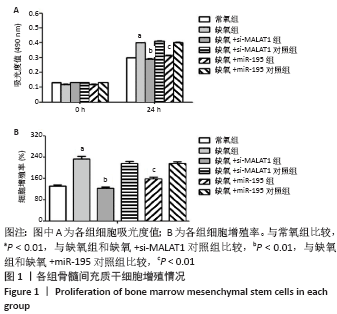
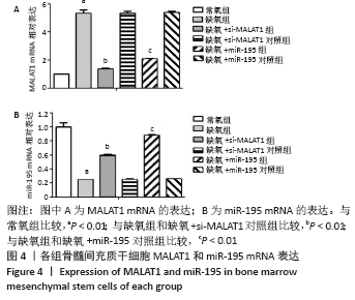
2.4 MALAT1和miR-195表达 采用qRT-PCR检测各组MALAT1和 miR-195的表达,结果显示:与常氧组相比,缺氧组MALAT1表达升高,miR-195表达下降,差异有显著性意义(P < 0.01)。缺氧+si-MALAT1组的MALAT1表达明显低于缺氧组和缺氧+si-MALAT1对照组(P < 0.01),而miR-195的表达则明显高于缺氧组和缺氧+si-MALAT1对照组(P < 0.01)。缺氧+miR-195组MALAT1的表达明显低于缺氧组和缺氧+miR-195对照组(P < 0.01),而miR-195的表达则明显高于缺氧组和缺氧+miR-195对照组(P < 0.01),见图4A和4B。"
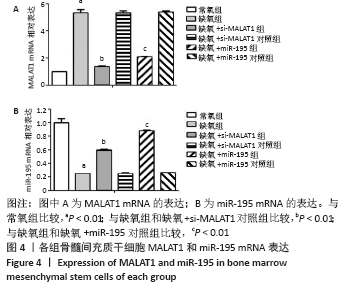
| [1] ZHU LP, TIAN T, WANG JY, et al. Hypoxia-elicited mesenchymal stem cell-derived exosomes facilitates cardiac repair through miR-125b-mediated prevention of cell death in myocardial infarction. Theranostics. 2018; 8(22):6163-6177. [2] LIU Y, YANG X, MAUREIRA P, et al. Permanently hypoxic cell culture yields rat bone marrow mesenchymal cells with higher therapeutic potential in the treatment of chronic myocardial infarction. Cell Physiol Biochem. 2017;44(3):1064-1077. [3] MENG SS, XU XP, CHANG W, et al. LincRNA-p21 promotes mesenchymal stem cell migration capacity and survival through hypoxic preconditioning. Stem Cell Res Ther. 2018;9(1):280. [4] FÁbián Z. The effects of hypoxia on the immune-modulatory properties of bone marrow-derived mesenchymal stromal cells. Stem Cells Int. 2019; 2019:2509606. [5] SELVASANDRAN K, MAKHOUL G, JAISWAL PK, et al. A tumor necrosis factor-α and hypoxia-induced secretome therapy for myocardial repair.Ann Thorac Surg. 2018;105(3):715-723. [6] CUI P, ZHAO X, LIU J, et al. miR-146a interacting with lncRNA EPB41L4A-AS1 and lncRNA SNHG7 inhibits proliferation of bone marrow-derived mesenchymal stem cells. J Cell Physiol. 2020;235(4):3292-3308. [7] 侯婧瑛,汪蕾,龙会宝,等.长链非编码RNA-H19 对缺血缺氧条件下骨髓间充质干细胞生存和血管再生能力的影响[J]. 中国组织工程研究,2018,22(13):1969-1975. [8] HUANG P, WANG L, LI Q, et al. Atorvastatin enhances the therapeutic efficacy of mesenchymal stem cells-derived exosomes in acute myocardial infarction via up-regulating long non-coding RNA H19. Cardiovasc Res. 2020;116(2):353-367. [9] LIU D, MIAO H, REN J, et al. Long non-coding RNA MALAT1 promotes proliferation, angiogenesis, and immunosuppressive properties of mesenchymal stem cells by inducing VEGF and IDO. J Cell Biochem. 2017;118(9):2780-2791. [10] REN L, WEI C, LI K, et al. LncRNA MALAT1 up-regulates VEGF-A and ANGPT2 to promote angiogenesis in brain microvascular endothelial cells against oxygen-glucose deprivation via targetting miR-145. Biosci Rep. 2019;39(3):BSR20180226. [11] TANG L, LU W, HUANG J, et al. miR‑144 promotes the proliferation and differentiation of bone mesenchymal stem cells by downregulating the expression of SFRP1. Mol Med Rep. 2019;20(1):270-280. [12] HONG Y, HE H, JIANG G, et al. miR-155-5p inhibition rejuvenates aged mesenchymal stem cells and enhances cardioprotection following infarction. Aging Cell. 2020;19(4):e13128. [13] OKADA M, KIM HW, MATSU-URA K, et al. Abrogation of Age-Induced MicroRNA-195 Rejuvenates the Senescent Mesenchymal Stem Cells by Reactivating Telomerase. Stem Cells. 2016;34(1):148-159. [14] ZHAO WJ, ZHANG HF, SU JY. Downregulation of microRNA-195 promotes angiogenesis induced by cerebral infarction via targeting VEGFA. Mol Med Rep. 2017;16(4):5434-5440. [15] HONG S, HU S, KANG Z, et al. Identification of functional lncRNAs based on competing endogenous RNA network in osteoblast differentiation. J Cell Physiol. 2020;235(3):2232-2244. [16] YI J, LIU D, XIAO J. LncRNA MALAT1 sponges miR-30 to promote osteoblast differentiation of adipose-derived mesenchymal stem cells by promotion of Runx2 expression. Cell Tissue Res. 2019;376(1): 113-121. [17] YANG X, YANG J, LEI P, et al. LncRNA MALAT1 shuttled by bone marrow-derived mesenchymal stem cells-secreted exosomes alleviates osteoporosis through mediating microRNA-34c/SATB2 axis. Aging (Albany NY). 2019;11(20):8777-8791. [18] STONE JK, KIM JH, VUKADIN L, et al. Hypoxia induces cancer cell-specific chromatin interactions and increases MALAT1 expression in breast cancer cells. J Biol Chem. 2019;294(29):11213-11224. [19] LIU H, ZHANG Z, XIONG W, et al. Long non-coding RNA MALAT1 mediates hypoxia-induced pro-survival autophagy of endometrial stromal cells in endometriosis. J Cell Mol Med. 2019;23(1):439-452. [20] LIU H, SHI C, DENG Y. MALAT1 affects hypoxia-induced vascular endothelial cell injury and autophagy by regulating miR-19b-3p/HIF-1α axis. Mol Cell Biochem. 2020;466(1-2):25-34. [21] 侯婧瑛,汪蕾,钟婷婷,等. apelin干预骨髓间充质干细胞在缺血缺氧条件下的生存和血管再生[J].中国组织工程研究,2017,21(1): 6-12. [22] HOU J, ZHONG T, GUO T, et al. Apelin promotes mesenchymal stem cells survival and vascularization under hypoxic-ischemic condition in vitro involving the upregulation of vascular endothelial growth factor. Exp Mol Pathol. 2017;102(2):203-209. [23] HOU J, WANG L, WU Q, et al. Long noncoding RNA H19 upregulates vascular endothelial growth factor A to enhance mesenchymal stem cells survival and angiogenic capacity by inhibiting miR-199a-5p. Stem Cell Res Ther. 2018;9(1):109. [24] 侯婧瑛,凌辉,金小岩,等. lncRNA-MALAT1通过靶向下调miR-570-3p促进胃癌细胞增殖[J].中国病理生理杂志,2018,34(12):2145-2152. [25] 侯婧瑛,周长青,郑韶欣,等.用双萤光素酶报告基因技术验证小鼠lncRNA-H19与miR-199a-5p的靶向关系[J].中国病理生理杂志, 2016,32(12):2256-2260. [26] PEZZI A, AMORIN B, LAUREANO Á, et al. Effects Of Hypoxia in Long-Term In Vitro Expansion of Human Bone Marrow Derived Mesenchymal Stem Cells. J Cell Biochem. 2017;118(10):3072-3079. [27] HU Y, CHEN W, WU L, et al. Hypoxic preconditioning improves the survival and neural effects of transplanted mesenchymal stem cells via CXCL12/CXCR4 signalling in a rat model of cerebral infarction. Cell Biochem Funct. 2019;37(7):504-515. [28] JAÉ N, HEUMÜLLER AW, FOUANI Y, et al. Long non-coding RNAs in vascular biology and disease. Vascul Pharmacol. 2019;114:13-22. [29] SUN Z, OU C, LIU J, et al. YAP1-induced MALAT1 promotes epithelial-mesenchymal transition and angiogenesis by sponging miR-126-5p in colorectal cancer. Oncogene. 2019;38(14):2627-2644. [30] YU B, GONG M, HE Z, et al. Enhanced mesenchymal stem cell survival induced by GATA-4 overexpression is partially mediated by regulation of the miR-15 family. Int J Biochem Cell Biol. 2013;45(12):2724-2735. [31] MA X, YAO H, YANG Y, et al. miR-195 suppresses abdominal aortic aneurysm through the TNF-α/NF-κB and VEGF/PI3K/Akt pathway. Int J Mol Med. 2018;41(4):2350-2358. [32] ZHU L, ZHONG Q, YANG T, et al. Improved therapeutic effects on diabetic foot by human mesenchymal stem cells expressing MALAT1 as a sponge for microRNA-205-5p. Aging (Albany NY). 2019;11(24): 12236-12245. [33] WANG QM, LIAN GY, SONG Y, et al. LncRNA MALAT1 promotes tumorigenesis and immune escape of diffuse large B cell lymphoma by sponging miR-195. Life Sci. 2019;231:116335. [34] LIU D, ZHU Y, PANG J, et al. Knockdown of long non-coding RNA MALAT1 inhibits growth and motility of human hepatoma cells via modulation of miR-195. J Cell Biochem. 2018;119(2):1368-1380. |
| [1] | Wang Jing, Xiong Shan, Cao Jin, Feng Linwei, Wang Xin. Role and mechanism of interleukin-3 in bone metabolism [J]. Chinese Journal of Tissue Engineering Research, 2022, 26(8): 1316-1322. |
| [2] | Xiao Hao, Liu Jing, Zhou Jun. Research progress of pulsed electromagnetic field in the treatment of postmenopausal osteoporosis [J]. Chinese Journal of Tissue Engineering Research, 2022, 26(8): 1323-1329. |
| [3] | An Weizheng, He Xiao, Ren Shuai, Liu Jianyu. Potential of muscle-derived stem cells in peripheral nerve regeneration [J]. Chinese Journal of Tissue Engineering Research, 2022, 26(7): 1130-1136. |
| [4] | Fan Yiming, Liu Fangyu, Zhang Hongyu, Li Shuai, Wang Yansong. Serial questions about endogenous neural stem cell response in the ependymal zone after spinal cord injury [J]. Chinese Journal of Tissue Engineering Research, 2022, 26(7): 1137-1142. |
| [5] | Tian Chuan, Zhu Xiangqing, Yang Zailing, Yan Donghai, Li Ye, Wang Yanying, Yang Yukun, He Jie, Lü Guanke, Cai Xuemin, Shu Liping, He Zhixu, Pan Xinghua. Bone marrow mesenchymal stem cells regulate ovarian aging in macaques [J]. Chinese Journal of Tissue Engineering Research, 2022, 26(7): 985-991. |
| [6] | Zhou Ying, Zhang Huan, Liao Song, Hu Fanqi, Yi Jing, Liu Yubin, Jin Jide. Immunomodulatory effects of deferoxamine and interferon gamma on human dental pulp stem cells [J]. Chinese Journal of Tissue Engineering Research, 2022, 26(7): 1012-1019. |
| [7] | Liang Xuezhen, Yang Xi, Li Jiacheng, Luo Di, Xu Bo, Li Gang. Bushen Huoxue capsule regulates osteogenic and adipogenic differentiation of rat bone marrow mesenchymal stem cells via Hedgehog signaling pathway [J]. Chinese Journal of Tissue Engineering Research, 2022, 26(7): 1020-1026. |
| [8] | Wang Jifang, Bao Zhen, Qiao Yahong. miR-206 regulates EVI1 gene expression and cell biological behavior in stem cells of small cell lung cancer [J]. Chinese Journal of Tissue Engineering Research, 2022, 26(7): 1027-1031. |
| [9] | Liu Feng, Peng Yuhuan, Luo Liangping, Wu Benqing. Plant-derived basic fibroblast growth factor maintains the growth and differentiation of human embryonic stem cells [J]. Chinese Journal of Tissue Engineering Research, 2022, 26(7): 1032-1037. |
| [10] | Wen Dandan, Li Qiang, Shen Caiqi, Ji Zhe, Jin Peisheng. Nocardia rubra cell wall skeleton for extemal use improves the viability of adipogenic mesenchymal stem cells and promotes diabetes wound repair [J]. Chinese Journal of Tissue Engineering Research, 2022, 26(7): 1038-1044. |
| [11] | Zhu Bingbing, Deng Jianghua, Chen Jingjing, Mu Xiaoling. Interleukin-8 receptor enhances the migration and adhesion of umbilical cord mesenchymal stem cells to injured endothelium [J]. Chinese Journal of Tissue Engineering Research, 2022, 26(7): 1045-1050. |
| [12] | Luo Xiaoling, Zhang Li, Yang Maohua, Xu Jie, Xu Xiaomei. Effect of naringenin on osteogenic differentiation of human periodontal ligament stem cells [J]. Chinese Journal of Tissue Engineering Research, 2022, 26(7): 1051-1056. |
| [13] | Wang Xinmin, Liu Fei, Xu Jie, Bai Yuxi, Lü Jian. Core decompression combined with dental pulp stem cells in the treatment of steroid-associated femoral head necrosis in rabbits [J]. Chinese Journal of Tissue Engineering Research, 2022, 26(7): 1074-1079. |
| [14] | Fang Xiaolei, Leng Jun, Zhang Chen, Liu Huimin, Guo Wen. Systematic evaluation of different therapeutic effects of mesenchymal stem cell transplantation in the treatment of ischemic stroke [J]. Chinese Journal of Tissue Engineering Research, 2022, 26(7): 1085-1092. |
| [15] | Guo Jia, Ding Qionghua, Liu Ze, Lü Siyi, Zhou Quancheng, Gao Yuhua, Bai Chunyu. Biological characteristics and immunoregulation of exosomes derived from mesenchymal stem cells [J]. Chinese Journal of Tissue Engineering Research, 2022, 26(7): 1093-1101. |
| Viewed | ||||||
|
Full text |
|
|||||
|
Abstract |
|
|||||
